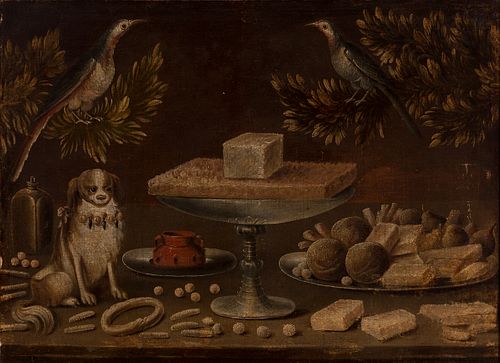Workshop of BLAS DE LEDESMA (Documented in Granada between 1602 and 1614); first half of the XVII century. "Still life". Oil on canvas. Relined.
Lot 52
About Seller
Setdart Auction House
Carrer Aragó 346
Barcelona
Spain
Setdart Subastas was born in 2004 and is currently the first online art auction in Spain with solidity, prestige and reliability guaranteed by our more than 60,000 users. Setdart has a young, dynamic and enterprising team ready to successfully manage the purchase and sale of art works through custom...Read more
Estimate:
EUR€8,000 - EUR€9,000
$8,421.05 - $9,473.68
Absentee vs Live bid
Two ways to bid:
- Leave a max absentee bid and the platform will bid on your behalf up to your maximum bid during the live auction.
- Bid live during the auction and your bids will be submitted real-time to the auctioneer.
Bid Increments
| Price | Bid Increment |
|---|---|
| EUR€0 | EUR€10 |
| EUR€200 | EUR€25 |
| EUR€500 | EUR€50 |
| EUR€1,000 | EUR€100 |
| EUR€3,000 | EUR€200 |
| EUR€5,000 | EUR€500 |
| EUR€10,000 | EUR€1,000 |
| EUR€20,000 | EUR€2,000 |
| EUR€50,000 | EUR€5,000 |
About Auction
By Setdart Auction House
Oct 20, 2021
Set Reminder
2021-10-20 07:30:00
2021-10-20 07:30:00
America/New_York
Bidsquare
Bidsquare : OLD MASTERS
https://www.bidsquare.com/auctions/setdart-auction-house/old-masters-7700
Setdart Auction House sofia@setdart.com
Setdart Auction House sofia@setdart.com
- Lot Description
Workshop of BLAS DE LEDESMA (Documented in Granada between 1602 and 1614); first half of the XVII century. "Still life". Oil on canvas. Relined. Presents repainting and damage. Size: 77 x 105.5 cm; 91 x 121.5 cm (frame). Baroque still life of symmetrical composition, which stands out for the abundance of food and animals that are presented on the table. The elements are arranged at various heights, creating a complex image, but at the same time very visual. The still life in Spain was one of the most characteristic genres and, due to its special peculiarities, it is clearly differentiated from the same theme in workshops in the rest of Europe. The term appeared already at the end of the 16th century, and stands out in this school for its austerity, in clear contrast with the Flemish sumptuousness, although with a series of influences from the latter and the Italian school. Sánchez Cotán's works were so successful that his style had numerous followers (Juan de Espinosa, Antonio Ponce, Juan van der Hamen y León, etc.). In this context, the Sevillian school contributed its own particularities, thanks, above all, to Velázquez and Zurbarán. Blas de Ledesma was one of the first Spanish artists to cultivate the still life. Although he is a very poorly documented artist, of whom only one signed work is preserved, we do know that in 1602 he was in Granada, working with Pedro de Raxis on the paintings of the dome that crowns the imperial staircase of the Monastery of Santa Cruz la Real. In fact, Pacheco praises him as a mural painter in his "Arte de la Pintura", and mentions him together with Pedro de Raxis and Antonio Mohedano as a follower of Giulio Aquili and Alejandro Mayner, who introduced the grotesques in the Alhambra Palace. In 1614 we find him documented again in Granada, drawing a plaster vault for the Mocárabes room of the Alhambra. He is also quoted as working in the cathedral with Miguel Cano. We know nothing more about his life until January 1616, when the Corpus Christi Brotherhood, to which he belonged, celebrated a mass for his soul, from which we deduce that he must have died at the end of 1615 or the beginning of the following year. We also know, however, that he was recognized as a painter of fruit bowls, as attested by Pedro Soto de Rojas, who dedicated some verses to him, comparing him to Zeuxis in his "Paraíso cerrado para muchos, jardines abiertos para pocos" (Paradise closed to many, gardens open to few) of 1652. To date we only know of one work signed by him that can be safely attributed to him, the "Still Life of Cherries" from the High Museum of Art in Atlanta (USA). It is a still life that evidences the knowledge of Juan Sánchez Cotán (present in Granada since 1604), characterized by a rigorously geometric composition, with the objects on a table in front of a black background, meticulously worked with great detail.
- Shipping Info
-
In-house shipping available. Please inquire at admin@setdart.com.
-
- Buyer's Premium



 EUR
EUR CAD
CAD AUD
AUD GBP
GBP MXN
MXN HKD
HKD CNY
CNY MYR
MYR SEK
SEK SGD
SGD CHF
CHF THB
THB









